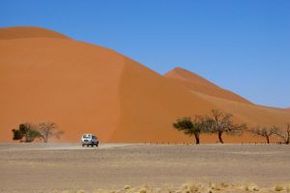Namibia Travel Guide
Namibia Travel: General Information
Namibia tourism can get as good as you can imagine, and at places even better. Namibia has it all – vast stretching deserts, coastal plains, mountains, rivers, canyons and a whole host of physical features. The contrasting landscapes of Namibia are not mere visual treats, they also promise you innumerable pleasure activities. Go sand gliding from the large sand-dunes of the Namib Desert or try cave-diving to explore the world’s largest subterranean lake, Dragon’s Breath. If the Etosha National Park provides excellent wildlife viewing, the Kavango and Caprivi regions are famous for bird-watching; again, there is enough scope for fishing in the coastal areas and river surroundings. There is much more to do – biking, hiking, canoeing, paragliding…
Namibia Travel: Key Facts
Capital city: Windhoek
Area: 825,418 sq km
Population: 2,088,669
Monetary Unit: Namibian Dollar
Official Language: English
International Dialing Code: 264
Namibia Travel: Popular Tourist Destinations
- Windhoek: Windhoek, the capital city surrounded by low hills, presents a perfectly picturesque setting. Windhoek’s pleasant climate is what brings people flocking here but the city is also ideal for doing some shopping. Make your pick from among the lovely local craft-items like hand-made wooden carvings, rugs or jewelry. Windhoek is famous for diamonds, semi-precious stones, the Windhoek beer and liqueur chocolates. Windhoek sightseeing attractions include its colonial period architecture apart from its natural-sites.
- Swakopmund: The beach city of Swakopmund is the summer-capital of Namibia. Frequented by anglers, beach-lovers and surfers, Swakopmund is now also becoming a favorite haunt of adrenaline junkies with attractions like camel-safari, hot-air balloon tours, sand-boarding and sky-diving. Swakopmund tourism includes visiting attractions like Swakopmund Lighthouse, the National Marine Aquarium, the Transport Museum and the Crystal Gallery. The city also attracts motley crowds with its bars and nightclubs.
- Other Popular Destinations: Namibia is full of tourist-destinations. While Walvis Bay’s attractions are its numerous adventure-sports/activities, Luderitz, away from the hurly-burly of modern life, is a must-visit for its nearby diamond-mines. Then there are Namibia’s numerous natural destinations like Damaraland, Ethosa Pan, Fish River Canyon, Sossusvlei & Sesriem and the national parks with their flora and fauna.
Namibia Travel: Economy and Infrastructure
Namibia has an export-oriented economy dominated by the mining sector. Rich in natural resources, particularly minerals, Namibia’s chief foreign currency earnings come from mining/export of minerals like Gold, Silver, Tungsten, Uranium, Zinc, etc. apart from gem-quality diamond and semi-precious stones. Although agriculture is Namibia’s second-important sector and employs about half of the populace, it generates only a small part of the GDP. With arid conditions prevailing, cattle-farming has been more successful than crop-farming; no wonder that Namibia is forced to import food-grains although it exports dairy products, processed meat and fish as well as hides. Other export items include beer and soft drinks. A fast-emerging economic sector of Namibia is tourism.
Namibia is one of the richest countries of Africa and has excellent communication and transport infrastructure. With its small population and stable government, Namibia should have promised better standards of living to the populace had it not been for the menaces of AIDS, unemployment and unequal wealth distribution (most of the cattle/ostrich farms are owned by white-farmers). The government is mulling over various ways of curbing poverty by privatizing state-owned enterprises and inviting foreign investors.
Namibia Travel: Culture
Namibia is a multi-ethnic country that has been under different rules at various points of time. Before Namibia’s independence in 1991, the Namibian populace was subject to the apartheid policy of racial and cultural discrimination. Now that the grim days of apartheid are over, the Namibian government and people are working towards building a society based on awareness, mutual respect and understanding, side-by-side preserving their rich heritage. Top cultural agendas of Namibia presently are as varied as wildlife conservation as well as conservation of traditional tribal arts/crafts and colonial arts, etc.
Recent Travel Guides from Namibia
Oranjemund, Namibia- Overview: The Forbidden Fairyland! On the bank of South Africa’s longest river - Orange River, lays the magnificent town of Oranjemund, Namibia. Dotted with greenery, the town is known not just because of its prime location in one of the largest diamond fields in the world, but also because of its natural beauty. Read more »
Windhoek, Namibia
The city of Windhoek (also known as Windhuk in German) is the capital city for the country of Namibia. This city is located somewhere on the northern side slopes of Khomas Highlands (which is also known as Khomas Hochland in local language). Officially the city of Windhoek is said to be part of the Khomas Region which is amongst the 13 region that are part of Namibia.... Read more »
Windhoek, Namibia
Being a relatively newer city, the development of Windhoek is still under process. In fact, the German influence is still obvious especially in its buildings, its establishment and the overall feel of the city. However, the slow but sure rise of the city, which is developing an identity of its own, will make this a very interesting destination of the future. ... Read more »
Windhoek, Namibia
Windhoek is the capital and the largest city of the African Republic of Namibia. Like most of its neighboring cities and countries. It has bore witness to a long history of being under European rule. In fact, it was once the capital of the German South-West Africa. Windhoek is situated in the Khomas Region and is home to approximately 230,000 people.... Read more »
Windhoek, Namibia
With the thriving and on the rise economy of Windhoek, it has adjusted to almost a Western way of living. During the day, the city is bustling with European cafes and most of its buildings have an obvious German influence. However, Namibian influence can be found on the quality and quantity of meat products because Windhoek is predominantly a carnivorous city. ... Read more »


